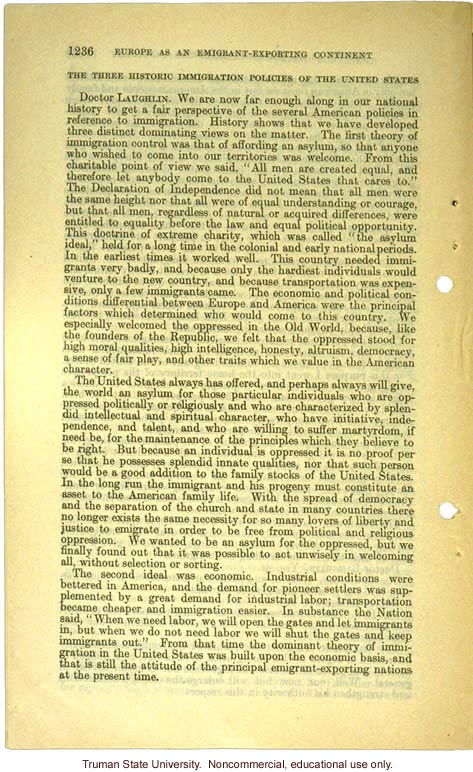1236 Europe as an Emigrant-Exporting Continent
The Three Historic Immigration Policies of the United States
Doctor Laughlin. We are now far enough along in our national history to get a fair perspective of the several American policies in reference to immigration. History shows that we have developed three distinct views on the matter. The first theory of immigration control was that of affording an asylum, so that anyone who wished to come into our territories was welcome. From this charitable point of view we said, "All men are created equal and therefore let anybody come to the United States that cares to." The Declaration of Independence did not mean that all men were the same height nor that all were of equal understanding or courage, but that all men, regardless of natural or acquired differences, were entitled to equality before the law and equal political opportunity. This doctrine of extreme charity, which was called "the asylum ideal," held for a long time in the colonial and early national periods. In the earliest times it worked well. This country needed immigrants very badly, and because only the hardiest individuals would venture to the new country, only a few immigrants came. The economic and political conditions differential between Europe and America were the principal factors which determined who would come to this country. We especially welcomed the oppressed in the Old World, because, like the founders of the Republic, we felt that the oppressed stood for high moral qualities, high intelligence, honesty, altruism, democracy, a sense of fair play, and other traits which we value in the American character.
The United States always has offered, and perhaps will give, the world an asylum for those particular individuals who are oppressed politically or religiously and who are characterized by splendid intellectual and spiritual character, who have initiative, independence, and talent, and who are willing to suffer martyrdom, if need be, for the maintenance of principles which they believe to be right. But because an individual is oppressed it is no proof per se that he possesses splendid innate qualities, nor that such person would be a good addition to the family stocks of the United States. In the long run the immigrant and his progeny must constitute an asset to the American family life. With the spread of democracy and the separation of the church and state in many countries there no longer exists the same necessity for so many lovers of liberty and justice to emigrate in order to be free from political and religious oppression. We wanted to be an asylum for the oppressed, but we finally found out that it was possible to act unwisely in welcoming all without selection or sorting.
The ideal was economic. Industrial conditions were bettered in America, and the demand for pioneer settlers, was supplemented by a greater demand for industrial labor; transportation became cheaper and immigration easier. In substance the Nation said, "We need labor, we will open the gates and let immigrants in, but when we do not need labor we will shut the gates and keep immigrants out." From that time the dominant theory of immigration in the United States was built upon the economic basis, and that is still the attitude of the principal emigrant-exporting nations at the present time.


